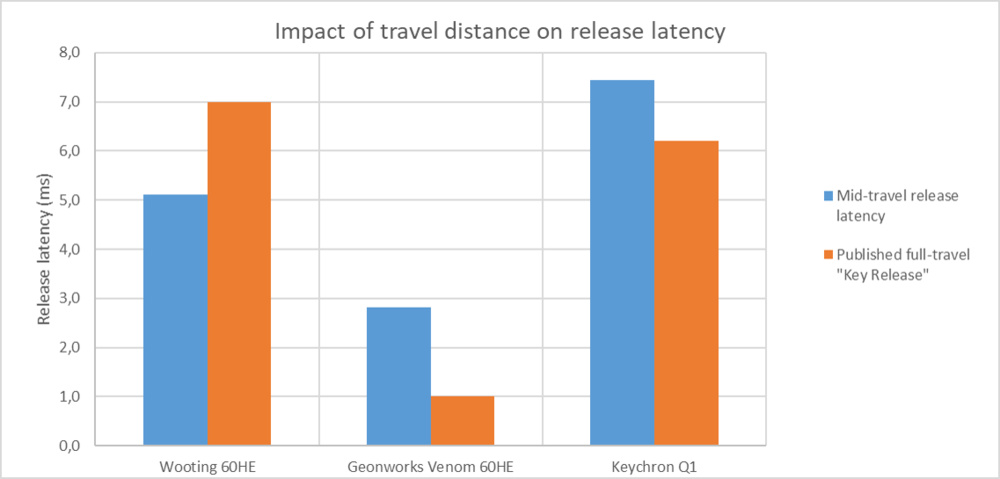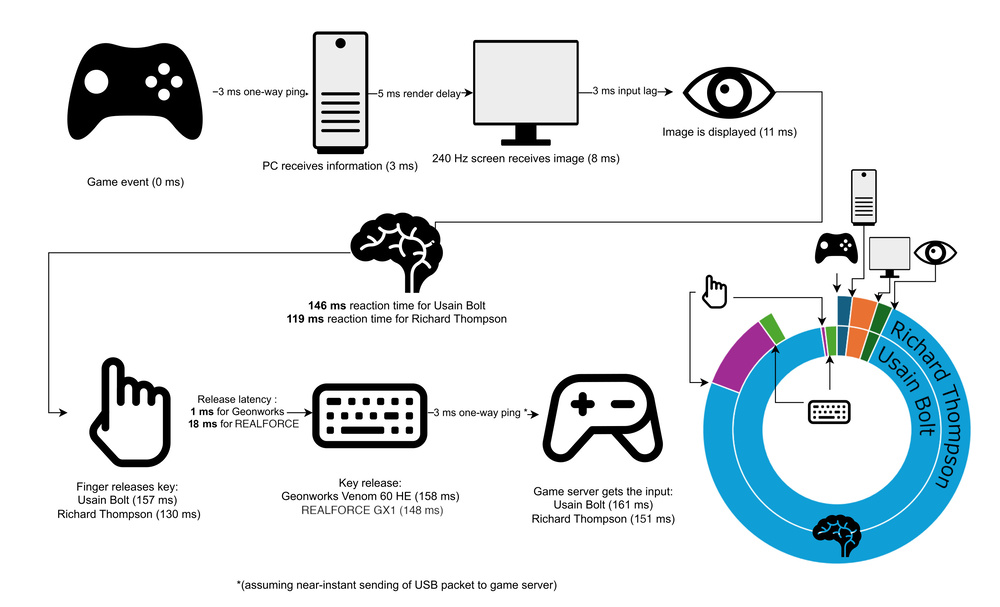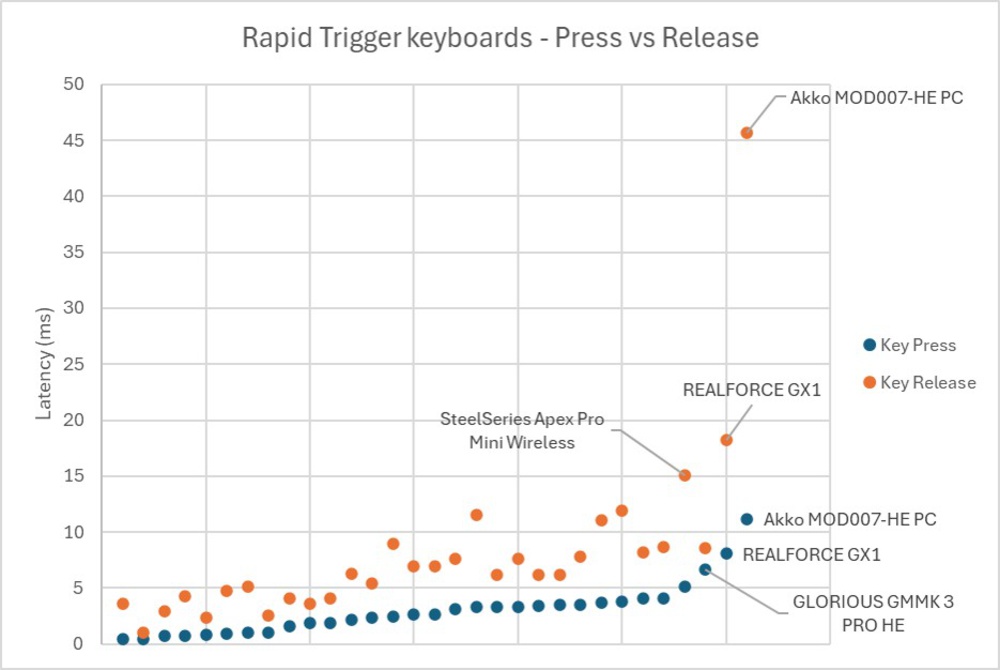Competitive gamers are always looking for ways to shave milliseconds off their input times. With the rise of switches featuring adjustable actuation, keyboard performance is finally catching up to that demand. One of the most talked-about innovations in recent years is rapid trigger, a feature that allows a key to reset as soon as it starts moving upward, rather than waiting for it to cross a fixed release point. This can dramatically reduce input delay, which is especially useful in fast-paced shooters or rhythm games.
But how much of an edge does it offer? And do the differences between rapid trigger keyboards even matter? We set out to investigate these questions and found that release latency on modern rapid trigger keyboards is already so low that measuring the small differences between them no longer adds meaningful value.
Ultimately, except for what we consider to be a single outlier keyboard, all rapid trigger-capable keyboards we tested get between 1 ms and 18 ms of release latency. That difference is smaller than the difference in reaction times between Olympic sprinters.
Test results
Modern Rapid Trigger Is Excellent
This relatively recent technology has improved in the last few years, making Hall effect (HE), optical, and, more recently, tunnel magnetoresistance (TMR) and inductive technology keyboards faster and more sensitive. Using these technological advancements, keyboard manufacturers are currently advertising a better implementation of rapid trigger, which garners customers' interest in getting a new keyboard that could give them an edge over their competition. In the last two years, the technology has become so great that every keyboard released on the market is incredibly fast.
First, some definitions. In keyboards with standard mechanical switches, a key is actuated once it's pressed past a set actuation point and released when it's moved above it. Whatever movements occur above and below the actuation point have no influence on the keyboard inputs. Contrarily, in keyboards with analog switches, the keyboard tracks the position of each key throughout its vertical travel. This allows for dynamic setting of the actuation point and, therefore, triggering based on a set vertical movement. In practice, this means it doesn't matter how deeply you press a key on a rapid trigger keyboard. The difference between the two triggering methods is shown in the video below:
Comparison of actuation between standard mechanical switches and analog switches.
By default, with rapid trigger keyboards, you must move a key all the way above its actuation point (adjustable in software) to reset it and make it ready to accept the next key press. Another feature some manufacturers implement is called continuous rapid trigger. This allows the user to press the key again before releasing fully, essentially using the same rapid trigger feature upside down.
Simply put, regular rapid trigger is useful in reducing release latency, while continuous rapid trigger can reduce the time between quickly repeating inputs. Since you don't need to worry about the proximity between your finger and the actuation point, a rapid trigger keyboard makes it easier to get the best input chain possible. The best input possible on a rapid trigger keyboard is also very often faster than that of a mechanical keyboard. Thus, if latency is important for you, you should probably avoid mechanical keyboards in your next keyboard purchase.
Rapid Trigger Latency Is Key Release Latency
In the context of this article, rapid trigger latency refers to the time between a key release starting from the middle of the key travel and the corresponding USB key release packet being sent by the keyboard. Key release latency refers to the same time difference, but with a key release starting from the bottom of the key travel.
As previously mentioned, we initially set out to create a new test for rapid trigger latency. However, our experimentation soon revealed that rapid trigger latency is directly correlated to key release latency.
Mid-travel release testing
We tested three different keyboards:
- Wooting 60HE, which we consider a reference, since it's the first keyboard to ship with rapid trigger enabled.
- Keychron Q1 HE, a more recent model.
- Geonworks Venom 60 HE, the highest performing keyboard we've tested at the time of writing, in regard to multi-key latency (both for key press and key release).
We measured their rapid trigger latency, the time delay between when a key is released from the middle of its travel and when the USB packet is sent. The first takeaway was that all three keyboards had a latency smaller than 10 ms. Even in the realm of high-end gaming keyboards, that is an excellent result.

These measurements result from a small-scale experimental test method, so they would need a noticeable error margin to be presented as absolute values. Still, our results demonstrate that rapid trigger latency is generally very close to key release latency. We are confident that a better test method would lead to even closer results. This highlights that those two tests measure the same aspect. With that information, we determined that key release latency could be used to inform rapid trigger latency.
Adding Some Perspective
A latency of 10 ms is generally considered very good, but one could even argue that it's good enough not to matter. Let's add some perspective. We want to emphasize that your reaction time is by far the largest contributor to your overall game latency and that this is where you stand to gain the largest advantage.
Sprinting to a better keyboard
In the context of video games, very often, you have to react to an event (whether that event be visual or auditory) with an input (a mouse or keyboard press or release). Simplifying for an excellent setup, keeping only the gamer reaction time and the keyboard latency variable, we have here two different situations. The first gamer has the reaction time of Usain Bolt (146 ms when he set his 100 m world record in 2009) and uses a Geonworks Venom 60 HE, the fastest keyboard we tested for release. The second gamer has the reaction time of Richard Thompson, who came fifth in that same race but had the fastest reaction time (119 ms), and uses a REALFORCE GX1, the worst adjustable actuation keyboard we tested for release latency, excluding one outlier.

First, you might be able to decipher from the donut chart that the main contributor to latency is not the keyboard (in purple) but the human reaction time (in blue). In that scenario, the REALFORCE would account for around 12 percent of the whole-system latency.
Second, the difference in reaction times between the fastest sprinter out of the blocks in that 100 m race (Richard Thompson at 119 ms) and the slowest (Darvis Patton at 149 ms) is 30 ms. That is approximately twice the difference between the REALFORCE and the GeonWorks (17 ms). The difference in reaction time between elite sprinters is twice the difference in latency between the worst and best keyboards. In other words, and with a touch of humor, if your reaction time is not faster than that of Usain Bolt, your keyboard is not what is keeping you back.
The Outlier: Akko MOD007-HE
During our investigation, we found one obvious outlier in the rapid trigger keyboard category. That board is the Akko MOD007-HE PC, which got results of 45.7 ms in key release latency and 11.2 ms in key press latency. Those two measurements are the worst of all rapid trigger keyboards we tested. Additionally, the input latency of that keyboard was very inconsistent, pointing to the firmware or the PCB being the limiting factor in its performance. Below is a graph displaying key press and key release latencies for all adjustable actuation keyboards we tested, ranked by key press latency. As you can see, even without the key release results, it would be obvious that the Akko performs worse than its competitors in latency. As an aside, that graph contains data points from keyboards released as early as 2019.

Modern gaming keyboards are in a different league
Keyboard latency has improved tremendously in the last five years. Below is a graph showing the trend in release latency, with productivity keyboards removed for clarity. Not only has the average keyboard improved a lot in the last years, but even the worst gaming keyboard released in 2025 that we tested is still better than the average one from three years ago.

Focusing only on modern keyboards, out of those released in 2024 and 2025, the only two "gaming" keyboards released slower than 15 ms are the Razer Joro and the Corsair K65 PLUS WIRELESS. These are portable scissor switch keyboards aimed at customizability and feel.

We're removing the key release latency measurement from our reviews, as the differences are too small to meaningfully impact performance, even at a highly competitive level. Key Press latency remains a more reliable and consistent way to identify the lowest-latency keyboards.
Holding the key halfway won't help you
To reiterate, excluding one outlier, the worst and the best rapid trigger keyboards we tested have 18 ms and 1 ms of release latency, respectively. Knowing that any modern keyboard will do, you might try to hold the key halfway to make the most out of your rapid trigger-enabled keyboard. That would make some sense, since analog switches use a deadzone at the bottom of their travel to prevent accidental releases, but don't bother. Finger speed is what you want to focus on.
As we mentioned earlier, we confirm that what we call key release latency and rapid trigger latency are very closely linked. However, this only applies to keyboards that use rapid trigger. In conventional mechanical keyboards, when a key is pressed, it's somewhat useful to hover as close as possible under the release point to reduce the time between the start of your finger movement and the moment the key passes the release point. However, the speed at which the key moved when it was released makes a measurable difference in all the rapid trigger boards we tested. If you use a rapid trigger keyboard, the only factor you can optimize is how fast you move your finger upwards; the position at which you hold it when you press a key doesn't matter. Now, you might be asking yourself how we measured the impact of finger speed on latency. The answer is simple: a servomotor.
A servomotor to test keyboards
To investigate rapid trigger latency, we built a servomotor-driven cam.
Our cam testing setup.
In that test, a servomotor drives a two-lobed cam. That cam presses a key to the approximate middle of its travel twice every rotation. When the keyboard releases, the host laptop sends an input to a Teensy development board (shown here on top of the aluminium structure), which sends an input to the servomotor driver board (background). This makes it so the driver board records the motor position at that instant. We know very precisely the motor position at which the cam hits its highest points, having measured the profile of the cam with a dial indicator. We calculate the mid-travel release delay with the known motor speeds and the difference between the recorded position and the cam lobe position.

As you can see, with increasing motor speed (and incidentally increasing key speed), the latency diminishes. For reference, with a few attempts, the fastest release speed I was personally able to achieve with my finger was roughly the same as the speed the servomotor achieved at 400 rotations per minute. A faster finger release leads to lower latency, regardless of key position.
Conclusion
After evaluating the rapid trigger performance of three keyboards, we confirmed that the key release latency results are a good measure of the quality of their implementation of rapid trigger. We found that nearly all recent rapid trigger keyboards, and most modern gaming keyboards, even those without rapid trigger, have excellent release latency. Trying to differentiate the tiny differences between them only undermines the clarity of our most reliable latency metric: single- and multi-key press latency. If you care about latency, getting the keyboard that performs best in key press latency will give you an excellent board in regard to release latency.
